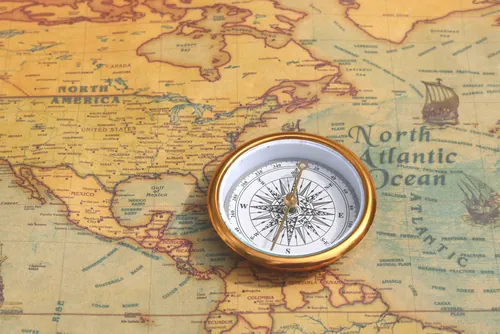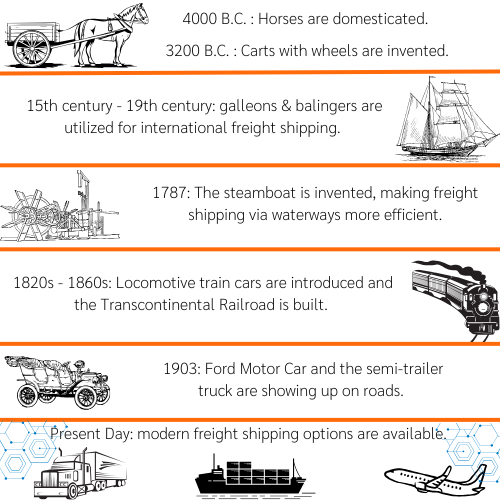The History of Logistics
The history of logistics is captivating. Spanning centuries and shaping the way goods are transported and traded across the globe, freight shipping has evolved from sacks being transported on carts to the advanced automated systems we rely on today.
So, how did freight shipping begin? Let’s step back in time to explore the history of freight shipping and how it came to be a complex system that powers modern commerce.

The Beginning
Trading and transporting goods have been fundamental parts of human civilization and how we operate as societies.
Beginning around 4000 B.C., horses were domesticated and used for the transportation of goods.
By 3200 B.C., wheeled carts were invented – the first in history – to further carrier improvements, leading to horses pulling these carts to transport people and goods.
It’s important to note that in the beginning stages of transportation, goods were often traded to neighboring civilizations or countries, as the resources for shipping long distances were not yet invented.
By 770 B.C., horse-drawn wagons became an extremely popular mode of shipping due to the invention of iron horseshoes, making it easier for horses to pull wagons over rocky and uneven terrain. However, it was still a slow and dangerous process.
As trading began to expand, merchants soon discovered that transporting goods by seas was more efficient, which led to the practice of loading goods onto ships in barrels, wood crates, or sacks.
Shipping via sea was often hazardous due to rough seas, stormy conditions, and pirates.
It’s no secret that planning, implementing, and managing the movement of goods is an essential part of successful freight shipping.
The concept of logistics itself dates back to the Roman and Greek militaries, who developed systems to manage the movement of supplies and goods for their armies.
Throughout history, logistics has been utilized primarily by militaries, especially during WWI and WWII. It wasn’t until the 1960s that businesses began to use logistics to manage their supply chains.
In the late 1700s. steamboats were invented, becoming the alternative to balingers, galleons, flatboats, or rafts that were previously used for freight shipping. Steamboats allowed for more efficient and safer transportation.
The 19th Century To Present Day
It wasn’t until the 19th century that freight shipping really began to advance. In the early 1800s, the U.S. started to implement plans for roads and canals.
Although cars would not be invented for another 100 years, wagons were the primary mode of transportation at the time.
Hence, the creation of roadways helped to further the efficient transportation of goods by giving the horse-drawn wagons a smoother terrain to travel on.
The 1820s introduced the railroad system, allowing goods to be transported quicker via a locomotive train car. By the 1860s, the Transcontinental Railroad, consisting of 3,500 miles of track, was completed.
The railroad allowed for freight to be transported from one end of the country to the other, a considerable feat for the industry.
Up until this period, international freight shipping had been around for centuries. It was only after the Industrial Revolution that the possibility of high-speed, mass-transport systems arose, which propelled the growing industry into the 20th century.
The mass production of gasoline vehicles by Ford Motor Company in the early 20th century set what we know today as road freight transportation into motion.
The freight industry would see immeasurable growth over the next 50 years, with the Motor Carrier Act being passed in 1935, which added regulations to the trucking industry, such as restricting the hours a trucker can drive, along with other rules and regulations for freight shipping companies.
By 1956, the Interstate Highway System was passed by President Eisenhower, which added 41,000 miles of new highway around the U.S., making it easier for larger trucks to carry freight around the country.
By the 1950s, around 173 billion ton-miles of commercial intercity freight was being transported via truck.
The 20th century saw many advancements in freight shipping, including shipping via aircraft and the invention of containerized cargo by Malcom P. McLean, which changed freight shipping as we know it today.
In the 21st century, the use of automation, AI, and other technologies has transformed freight transportation to be more efficient, environmentally sustainable, and cost-effective, allowing for faster delivery times, reduced human error, and optimized resource management across global supply chains.
The history of freight shipping and logistics is a testament to the drive to connect people and goods across far distances. From ancient trade routes to the modern global supply chains, logistics has evolved extensively.
As we look ahead to the future, the continued development of logistics systems and freight shipping promises to drive further efficiency, innovation and connectivity.


